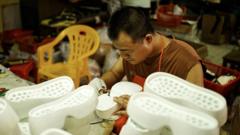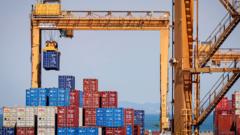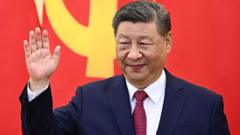As the trade war continues, many small businesses in China report stagnation and layoffs due to high tariffs imposed on their exports to the US.
"Chinese Small Businesses Feel the Pinch of Trump's Tariffs Amid Trade Tensions"

"Chinese Small Businesses Feel the Pinch of Trump's Tariffs Amid Trade Tensions"
Economic uncertainty looms over China's small businesses as Trump's tariffs lead to halted production and worries for the future.
In the bustling trading environment of Guangzhou, the Canton Fair has become a stark reflection of the wider economic struggles faced by small Chinese businesses as they navigate through the turbulent waters of Trump's tariffs. “This is so hard for us,” states Lionel Xu of Sorbo Technology, surrounded by unsold mosquito repellent kits that were once best sellers in Walmart, now stockpiled in a warehouse due to the steep 145% tariffs on Chinese imports enforced by the US.
Frustration is palpable among business owners like Xu, whose company relies heavily on the US market for approximately half of its sales. “We are worried. What if Trump doesn't change his mind?” he poses, capturing the anxiety gripping many in the industry. Alongside him, Amy from Guangdong Sailing Trade Company shares similar sentiments, noting halted production and warehouses full of unsold ice cream makers, their key US buyers now limited by rising costs.
Recent moves by President Trump to pause tariffs saw a brief respite in the market; however, the import levies targeting Chinese goods remain intact, further complicating trade dynamics. Over 30,000 businesses showcased their products at the fair, yet the burden of increased costs due to tariffs is daunting. Many American firms are now unable to absorb these prices without passing them onto consumers, risking a slump in demand.
The trade war has positioned the US and China in a stalemate, with Chinese exports piling up, leading to a dire economic reality. Despite a sizeable domestic market within China, consumer spending remains sluggish as many prioritize saving amid falling property values. Exports have historically been a vital component of China’s economy, contributing significantly to growth, and with tens of millions employed in export-oriented jobs, the ramifications of this trade tension resonate deeply.
On the ground in Guangdong, workers from various manufacturing sectors, such as clothing, footwear, and accessories, express their dismay over financial struggles and reduced wages. “We’ve had problems since the Covid pandemic, and now there’s this trade war,” laments a factory worker, highlighting the growing discontent as the economic landscape shifts beneath them.
As Chinese businesses consider new opportunities, some are exploring uncharted territories in Europe, the Middle East, and Russia to diversify markets. Meanwhile, the lingering trade standoff between the two economic powerhouses, aggravated by lack of communication, spells continued uncertainty ahead.
While businesses remain hopeful for a thaw in relations, the reality is, without a strategic resolution to the trade discord, the impact of tariffs on both sides will likely escalate, cementing a complex chapter in US-China relations. Despite facing adversity, some are adapting to keep afloat, but with cautious optimism, many still echo the sentiments of uncertainty.
Frustration is palpable among business owners like Xu, whose company relies heavily on the US market for approximately half of its sales. “We are worried. What if Trump doesn't change his mind?” he poses, capturing the anxiety gripping many in the industry. Alongside him, Amy from Guangdong Sailing Trade Company shares similar sentiments, noting halted production and warehouses full of unsold ice cream makers, their key US buyers now limited by rising costs.
Recent moves by President Trump to pause tariffs saw a brief respite in the market; however, the import levies targeting Chinese goods remain intact, further complicating trade dynamics. Over 30,000 businesses showcased their products at the fair, yet the burden of increased costs due to tariffs is daunting. Many American firms are now unable to absorb these prices without passing them onto consumers, risking a slump in demand.
The trade war has positioned the US and China in a stalemate, with Chinese exports piling up, leading to a dire economic reality. Despite a sizeable domestic market within China, consumer spending remains sluggish as many prioritize saving amid falling property values. Exports have historically been a vital component of China’s economy, contributing significantly to growth, and with tens of millions employed in export-oriented jobs, the ramifications of this trade tension resonate deeply.
On the ground in Guangdong, workers from various manufacturing sectors, such as clothing, footwear, and accessories, express their dismay over financial struggles and reduced wages. “We’ve had problems since the Covid pandemic, and now there’s this trade war,” laments a factory worker, highlighting the growing discontent as the economic landscape shifts beneath them.
As Chinese businesses consider new opportunities, some are exploring uncharted territories in Europe, the Middle East, and Russia to diversify markets. Meanwhile, the lingering trade standoff between the two economic powerhouses, aggravated by lack of communication, spells continued uncertainty ahead.
While businesses remain hopeful for a thaw in relations, the reality is, without a strategic resolution to the trade discord, the impact of tariffs on both sides will likely escalate, cementing a complex chapter in US-China relations. Despite facing adversity, some are adapting to keep afloat, but with cautious optimism, many still echo the sentiments of uncertainty.





















